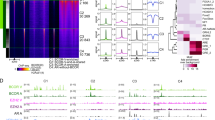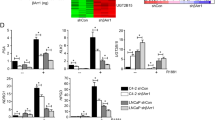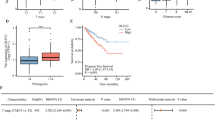Abstract
The oncogene Bcl-2 is upregulated frequently in prostate tumors following androgen ablation therapy, and Bcl-2 overexpression may contribute to the androgen-refractory relapse of the disease. However, the molecular mechanism underlying androgenic regulation of Bcl-2 in prostate cancer cells is understood poorly. In this study, we demonstrated that no androgen response element (ARE) was identified in the androgen-regulated region of the P1 promoter of Bcl-2 gene, whereas, we provided evidence that the androgenic effect is mediated by E2F1 protein through a putative E2F-binding site in the promoter. We further demonstrated that retinoblastoma (RB) protein plays a critical role in androgen regulation of Bcl-2. The phosphorylation levels of RB at serine residues 780 and 795 were decreased in LNCaP cells treated with androgens. Ectopic expression of a constitutively active form of RB inhibited expression of Bcl-2. Knockdown of endogenous RB protein by an Rb small inference RNA (siRNA) induced an increase in Bcl-2 levels. Most importantly, the effect of androgens on Bcl-2 was abolished completely by specific inhibition of RB function with a mutated E1A. Finally, androgen treatment of LNCaP cells upregulated specifically levels of the cyclin-dependent kinase inhibitors (CDKIs) p15INK4B and p27KIP1. Ectopic expression of p15INK4B and/or p27KIP1 inhibited Bcl-2 expression. Knockdown of endogenous p15INK4B or p27KIP1 protein with a pool of siRNAs diminished androgen-induced downregulation of Bcl-2 expression. Therefore, our data indicate that androgens suppress Bcl-2 expression through negatively modulating activities of the E2F site in the Bcl-2 promoter by activating the CDKI-RB axis.
This is a preview of subscription content, access via your institution
Access options
Subscribe to this journal
Receive 50 print issues and online access
$259.00 per year
only $5.18 per issue
Buy this article
- Purchase on Springer Link
- Instant access to full article PDF
Prices may be subject to local taxes which are calculated during checkout










Similar content being viewed by others
Abbreviations
- AR:
-
androgen receptor
- ARE:
-
androgen response element
- RB:
-
retinoblastoma protein
- CDK:
-
cyclin-dependent kinase
- CDKI:
-
cyclin-dependent kinase inhibitor
- ChIP:
-
chromatin immunoprecipitation
- siRNA:
-
small interference RNA
References
Agus DB, Cordon-Cardo C, Fox W, Drobnjak M, Koff A, Golde DW and Scher HI . (1999). J. Natl. Cancer Inst., 91, 1869–1876.
Bruckheimer EM, Spurgers K, Weigel NL, Logothetis C and McDonnell TJ . (2003). J. Urol., 169, 1553–1557.
Butler R, Mitchell SH, Tindall DJ and Young CY . (2000). Cell Growth Differ., 11, 49–61.
Cheema SK, Mishra SK, Rangnekar VM, Tari AM, Kumar R and Lopez-Berestein G . (2003). J. Biol. Chem., 278, 19995–20005.
Chi KN, Gleave ME, Klasa R, Murray N, Bryce C, Lopes de Menezes DE, D'Aloisio S and Tolcher AW . (2001). Clin. Cancer Res., 7, 3920–3927.
Colombel M, Symmans F, Gil S, O'Toole KM, Chopin D, Benson M, Olsson CA, Korsmeyer S and Buttyan R . (1993). Am. J. Pathol., 143, 390–400.
Cordon-Cardo C, Koff A, Drobnjak M, Capodieci P, Osman I, Millard SS, Gaudin PB, Fazzari M, Zhang ZF, Massague J and Scher HI . (1998). J. Natl. Cancer Inst., 90, 1284–1291.
Decary S, Decesse JT, Ogryzko V, Reed JC, Naguibneva I, Harel-Bellan A and Cremisi CE . (2002). Mol. Cell. Biol., 22, 7877–7888.
Denmeade SR, Lin XS and Isaacs JT . (1996). Prostate, 28, 251–265.
Dorai T, Goluboff ET, Olsson CA and Buttyan R . (1997a). Anticancer Res., 17, 3307–3312.
Dorai T, Olsson CA, Katz AE and Buttyan R . (1997b). Prostate, 32, 246–258.
Fernandez A, Udagawa T, Schwesinger C, Beecken W, Achilles-Gerte E, McDonnell T and D'Amato R . (2001). J. Natl. Cancer Inst., 93, 208–213.
Gleave M . (1999). Prostate Cancer Prostatic. Dis., 2, S15.
Gleave M, Tolcher A, Miyake H, Nelson C, Brown B, Beraldi E and Goldie J . (1999a). Clin. Cancer Res., 5, 2891–2898.
Gleave ME, Miayake H, Goldie J, Nelson C and Tolcher A . (1999b). Urology, 54, 36–46.
Gomez-Manzano C, Mitlianga P, Fueyo J, Lee HY, Hu M, Spurgers KB, Glass TL, Koul D, Liu TJ, McDonnell TJ and Yung WK . (2001). Cancer Res., 61, 6693–6697.
Graff JR, Konicek BW, McNulty AM, Wang Z, Houck K, Allen S, Paul JD, Hbaiu A, Goode RG, Sandusky GE, Vessella RL and Neubauer BL . (2000). J. Biol. Chem., 275, 24500–24505.
Green DR . (2000). Cell, 102, 1–4.
Grossmann ME, Huang H and Tindall DJ . (2001). J. Natl. Cancer Inst., 93, 1687–1697.
Haldar S, Basu A and Croce CM . (1997). Cancer Res., 57, 229–233.
Hiyama H, Iavarone A and Reeves SA . (1998). Oncogene, 16, 1513–1523.
Huang H, Cheville JC, Pan Y, Roche PC, Schmidt LJ and Tindall DJ . (2001). J. Biol. Chem., 276, 38830–38836.
Huang H, Reed CP, Zhang JS, Shridhar V, Wang L and Smith DI . (1999). Cancer Res., 59, 2981–2988.
Huang H and Tindall DJ . (2002). Crit. Rev. Eukaryot. Gene Expr., 12, 193–207.
Huggins C and Hodge CV . (1941). Cancer Res., 1, 293–297.
Isaacs JT . (1984). Prostate, 5, 545–557.
Jiang Z and Zacksenhaus E . (2002). J. Cell. Biol., 156, 185–198.
Johnson DG, Ohtani K and Nevins JR . (1994). Genes Dev., 8, 1514–1525.
Kimura K, Markowski M, Bowen C and Gelmann EP . (2001). Cancer Res., 61, 5611–5618.
Krajewska M, Krajewski S, Epstein JI, Shabaik A, Sauvageot J, Song K, Kitada S and Reed JC . (1996). Am. J. Pathol., 148, 1567–1576.
Kyprianou N, English HF and Isaacs JT . (1990). Cancer Res., 50, 3748–3753.
Lapointe J, Fournier A, Richard V and Labrie C . (1999). Endocrinology, 140, 416–421.
Li JM, Nichols MA, Chandrasekharan S, Xiong Y and Wang XF . (1995). J. Biol. Chem., 270, 26750–26753.
Liu SL, Rand A, Kelm Jr RJ and Getz MJ . (2000). Oncogene, 19, 3352–3362.
Lu L, Schulz H and Wolf DA . (2002). BMC Cell Biol., 3, 22.
Masiello D, Cheng S, Bubley GJ, Lu ML and Balk SP . (2002). J. Biol. Chem., 277, 26321–26326.
McDonnell TJ, Navone NM, Troncoso P, Pisters LL, Conti C, von Eschenbach AC, Brisbay S and Logothetis CJ . (1997). J. Urol., 157, 569–574.
McDonnell TJ, Troncoso P, Brisbay SM, Logothetis C, Chung LW, Hsieh JT, Tu SM and Campbell ML . (1992). Cancer Res., 52, 6940–6944.
Miyake H, Tolcher A and Gleave ME . (1999). Cancer Res., 59, 4030–4034.
Miyashita T, Harigai M, Hanada M and Reed JC . (1994). Cancer Res., 54, 3131–3135.
Murillo H, Huang H, Schmidt LJ, Smith DI and Tindall DJ . (2001). Endocrinology, 142, 4795–4805.
Neuman E, Flemington EK, Sellers WR and Kaelin Jr WG . (1994). Mol. Cell. Biol., 14, 6607–6615.
Raffo AJ, Perlman H, Chen MW, Day ML, Streitman JS and Buttyan R . (1995). Cancer Res., 55, 4438–4445.
Seto M, Jaeger U, Hockett RD, Graninger W, Bennett S, Goldman P and Korsmeyer SJ . (1988). EMBO J., 7, 123–131.
Swinnen JV, Ulrix W, Heyns W and Verhoeven G . (1997). Proc. Natl. Acad. Sci. USA, 94, 12975–12980.
Tsihlias J, Zhang W, Bhattacharya N, Flanagan M, Klotz L and Slingerland J . (2000). Oncogene, 19, 670–679.
Tsujimoto Y and Croce CM . (1986). Proc. Natl. Acad. Sci. USA, 83, 5214–5218.
Vigo E, Muller H, Prosperini E, Hateboer G, Cartwright P, Moroni MC and Helin K . (1999). Mol. Cell. Biol., 19, 6379–6395.
Weinmann AS, Bartley SM, Zhang T, Zhang MQ and Farnham PJ . (2001). Mol. Cell. Biol., 21, 6820–6832.
Westin P, Stattin P, Damber JE and Bergh A . (1995). Am. J. Pathol., 146, 1368–1375.
Wilson BE, Mochon E and Boxer LM . (1996). Mol. Cell. Biol., 16, 5546–5556.
Yang RM, Naitoh J, Murphy M, Wang HJ, Phillipson J, deKernion JB, Loda M and Reiter RE . (1998). J. Urol., 159, 941–945.
Zegarra-Moro OL, Schmidt LJ, Huang H and Tindall DJ . (2002). Cancer Res., 62, 1008–1013.
Acknowledgements
We thank Drs LM Boxer, RJ Kelm, JR Nevins, and Z Zacksenhaus for plasmids. This work was supported in part by a grant (DK60920) from the National Institutes of Health and a grant from the TJ Martell Foundation (DJT), and a developmental award of the Mayo Prostate Cancer SPORE (CA91956) funded by the National Cancer Institute (HH).
Author information
Authors and Affiliations
Corresponding author
Rights and permissions
About this article
Cite this article
Huang, H., Zegarra-Moro, O., Benson, D. et al. Androgens repress Bcl-2 expression via activation of the retinoblastoma (RB) protein in prostate cancer cells. Oncogene 23, 2161–2176 (2004). https://doi.org/10.1038/sj.onc.1207326
Received:
Revised:
Accepted:
Published:
Issue Date:
DOI: https://doi.org/10.1038/sj.onc.1207326
Keywords
This article is cited by
-
Sanguinarine chloride induces ferroptosis by regulating ROS/BACH1/HMOX1 signaling pathway in prostate cancer
Chinese Medicine (2024)
-
High-dose-androgen-induced autophagic cell death to suppress the Enzalutamide-resistant prostate cancer growth via altering the circRNA-BCL2/miRNA-198/AMBRA1 signaling
Cell Death Discovery (2022)
-
Suppressing BCL-XL increased the high dose androgens therapeutic effect to better induce the Enzalutamide-resistant prostate cancer autophagic cell death
Cell Death & Disease (2021)
-
Sensitisation to mitoxantrone-induced apoptosis by the oncolytic adenovirus Ad∆∆ through Bcl-2-dependent attenuation of autophagy
Oncogenesis (2018)
-
Linking prostate cancer cell AR heterogeneity to distinct castration and enzalutamide responses
Nature Communications (2018)



